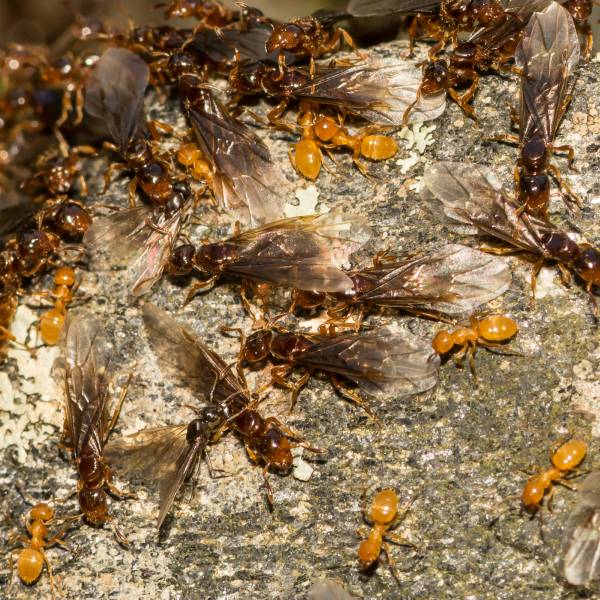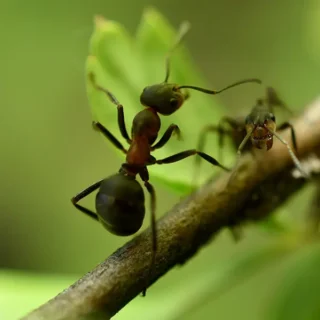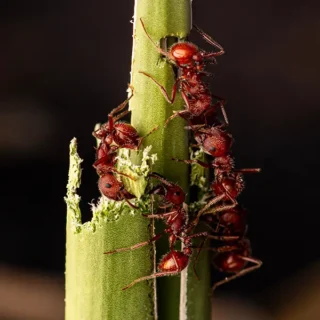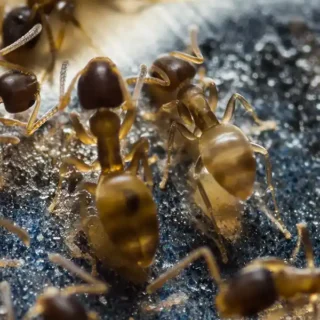Citronella Ants in Suffolk County & Nassau County
The citronella ant (also known as the larger yellow ant) is common in the Suffolk County & Nassau County area. When disturbed, citronella ants release a compound that smells like citronella or lemon — hence their name. As nocturnal pests, these ants are not known to feed on household foods but feed exclusively on the honeydew produced by aphids and mealybugs. Pest problems usually occur in the late summer and fall when mixed colonies swarm. Often confused with termites, winged swarmers and wingless worker ants move toward buildings and try to enter through cracks or gaps in the foundation.
Citronella Ant Habitat
Nests are typically located in and around areas of high moisture. Outdoors, larger yellow ants can be found nesting in high-moisture soil beside structures, along foundation walls, under stumps, logs, or rocks. Indoors, these ants are sometimes found behind bathtubs or shower walls or in damp crawl spaces, especially over winter. Mounds of dirt left behind by the colonies’ process of excavating tunnels can be up to three feet wide. Temporary winter nests can be located in basements under a loose brick or board or in a crack in the wall or floor.
Citronella Ant Behaviors, Threats, or Dangers
Citronella ants do not have a stinger but can become a nuisance when winged ants swarm indoors, or as workers dump soil from cracks in floors or basement walls. When swarming, homeowners often mistake these ants for termites or carpenter ants. Homeowners may be alarmed by the large numbers of swarming ants that converge on the side of homes and structures. Although they do not forage into homes, they create piles of dirt at the entrance to the nest. If a larger yellow ant issue is suspected, it is best to consult a professional ant exterminator.
Citronella Ant FAQs
What do citronella ants look like?
Citronella ants are larger than most ants — which is why they’re sometimes called the “larger yellow ant.” They’re yellow to orangeish in color with antennae. Swarmers will have two sets of wings and are easily mistaken for termites.
What are the signs you have citronella ants in your home?
Citronella ants are named so because of the lemon or citronella-like smell that they give off when they are crushed. Another interesting fact about citronella ants is that they are nocturnal and are rarely seen by homeowners.
Outside, citronella ants will nest in moist soil that is found along the house foundation, underneath concrete slabs, and under rotten trees or logs. Inside homes, they will nest in areas of high moisture like behind the tiled walls of bathrooms, underneath the bathroom or kitchen floors, and in moist crawl spaces.
Citronella ants almost exclusively feed on honeydew excreted from insects that live under the ground and feed on the roots of plants. They rarely, if ever, will feed on food that is found in homes.
What damage do citronella ants cause?
Unlike carpenter ants that are destructive to homes and other structures, citronella ants are not dangerous to property.
To prevent citronella ants, follow the same basic principles you would to prevent other types of ant infestations. Here are some additional tips that are helpful with citronella ants:
- Woodpiles, compost piles, and outdoor trash should be placed/stored away from your home.
- Make sure that gutters are working properly to direct water away from your home and its foundation.
- Repair or replace any leaky outdoor fixtures, indoor fixtures, pipes, or faucets.
- Remove and/or replace any wood in your home that has been damaged by water.
- Seal any cracks or crevices in your home’s foundation or exterior walls; install door sweeps on all exterior doors.
How do you get rid of citronella ants?
You can try to vacuum citronella ants to remove them, but they are small and can hide well. Ant traps may have a small effect also. However, to truly stop a citronella ant infestation, we recommend calling a professional ant control specialist.
Not really. Citronella ants do not have a stinger and do not bite either so they are not a threat to human health. They are considered nuisance ants. Many people don’t enjoy the smell they release when threatened or crushed, but it can’t harm you.
Need help with Citronella Ant control?
Need Expert Advice?
Leave your information below and we'll be in touch soon!
"*" indicates required fields
*During normal business hours. After hours calls will be returned the next business day.





